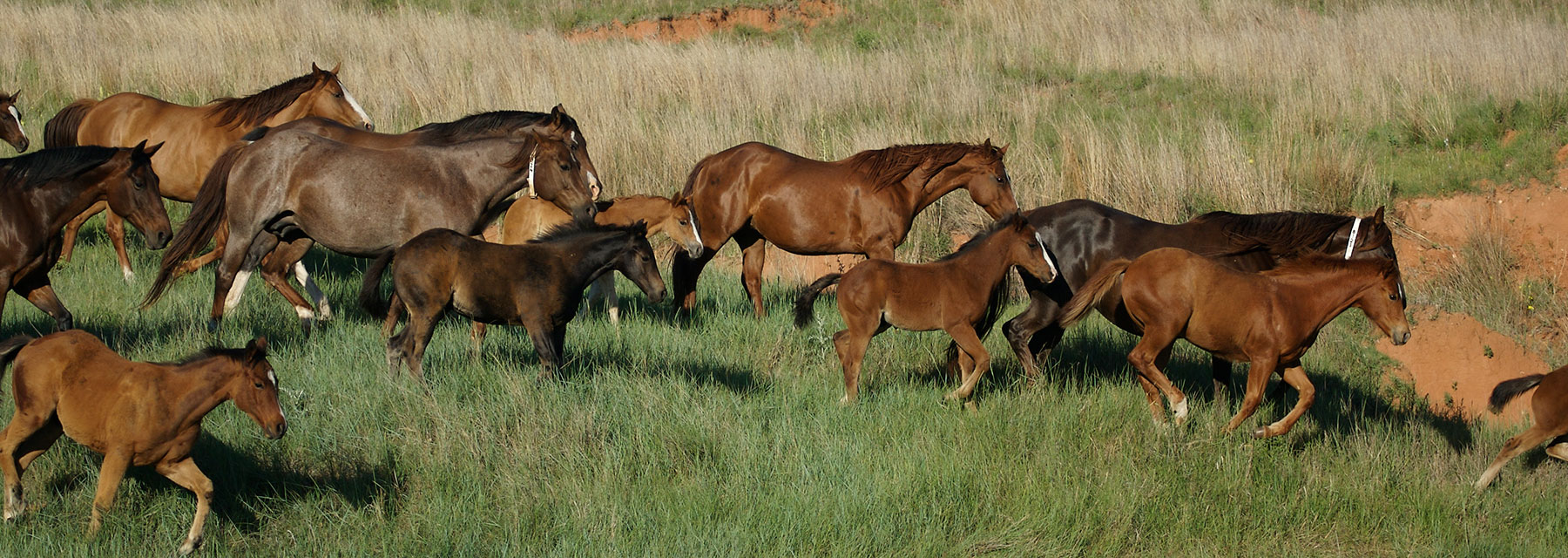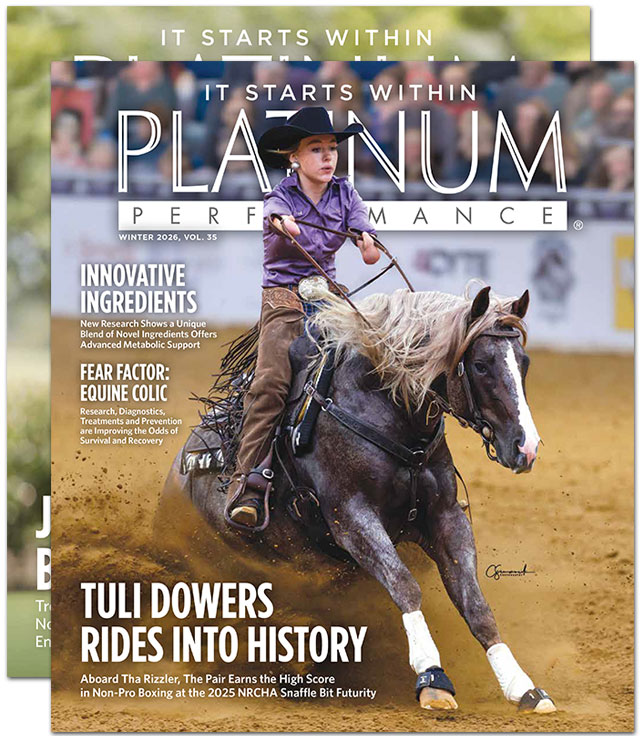An Inside View of Equine Reproduction From Theriogenologists Dr. Elaine Carnevale,
Dr. Dickson Varner, Dr. Charlie Scoggin & Dr. Jennifer Hatzel
Theriogenologists are on the front lines of life. They breed tomorrow's champions, establish novel techniques and spur monumental advancements that build on today's standards while developing the tools of tomorrow. Among them are three pioneers who collectively have influenced the way the world views equine reproduction. Dr. Elaine Carnevale of Colorado State University, along with Dr. Dickson Varner of Texas A&M, have made far-reaching strides at premier universities in the study of mares and stallions respectively, while Dr. Charlie Scoggin has moved reproduction forward from a clinical perspective, working in the heart of bluegrass country with the revered Rood & Riddle Equine Hospital. In addition to the three greats, Dr. Jennifer Hatzel is positioning herself to contribute to the future of equine reproduction. Under the tutelage of Dr. Carnevale, this Colorado State University veterinarian is hitting her stride as a promising young mind in the field. Each of the four theriogenologists began their careers at different points in the last several decades, and in that time have seen the landscape in equine reproduction progress significantly.
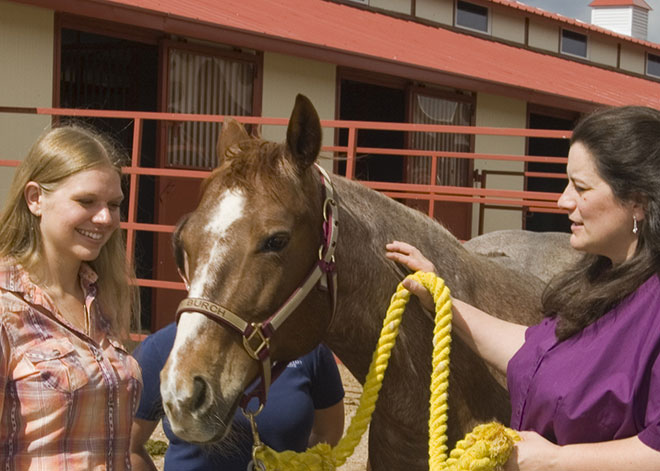
Dr. Elaine Carnevale, Colorado State University
The Mare Visionary
Meet Dr. Carnevale, and you'll quickly realize that you're looking into the face of pure determination. She's a brilliant advocate of the mare, pairing a lifelong love of horses with a vast knowledge of the intricacies involved in mare fertility. Her fascination with the mare is both unending and inspiring. She's seen it all, worked in the trenches through decades of breeding seasons, and still she charges forward with a thirst for more. "It's seeing life at the beginning," she says of her love for breeding mares. "I grew up very horse crazy. And to this day, coming out to the repro lab and seeing some of those old, gray foundation mares, I just love them. It still kind of amazes me. Every time I see an oocyte I still think it's incredible." It's an enthusiasm that she's passing along to the next generation of veterinarians who hope to make just as significant of an impact on the field of reproduction. One such specialist is theriogenologist Dr. Jennifer Hatzel. Under the guidance of Dr. Carnevale, Dr. Hatzel has dove head first into the world of mare fertility. "I have a fascination with everything behind equine reproduction," says Dr. Hatzel. "Although we've come so far with research and incredible discoveries, there's still so many questions and so much to explore."
The Transformation of Mare Reproduction
In just a few short decades, the techniques surrounding mare reproduction have gone from experimental concepts in the late 1980s to routine and highly successful procedures today. "When I started in repro as a master's student just after getting my DVM from CSU, they were still figuring everything out with ultrasound," remembers Dr. Carnevale. "They knew the basics, but it was still being perfected as a tool." In her early days at Colorado State, reproductive technology was in a vastly different place. "Reproduction as it pertained to mares revolved around ultrasound, synchronizing cycles, the concept of super ovulation and a lot of breeding soundness evaluations," she says. "Looking back, it's clear that our techniques have advanced significantly." Dr. Charlie Scoggin agrees, "Back then a lot of the techniques were just emerging," he remembers. "Dr. Carnevale's oocyte program was building up a lot of steam and embryo transfer was somewhat limited to more specialty-type hospitals." One of those hospitals was the widely-respected Colorado State University, where Dr. Carnevale is part of an assisted reproduction program that is unquestionably amongst the very best in the world. "It was about 1989 when we were first trying to recover oocytes from mares and put them back into inseminated recipients," she says. "I was part of the team that did the first oocyte transfer baby while I was a master's student at CSU, but at that time it took 15 oocytes to get one foal." Along with oocytes, the state of embryo transfer technology was a far cry from its place in reproduction today. "CSU was still doing quite a lot of surgical embryo transfers when I came back to the program in the late nineties to start a clinical assisted reproduction program," says Dr. Carnevale. At that time, Dr. Carnevale and Colorado State started to propel assisted reproduction technology forward by using oocyte transfer and ICSI as clinical procedures.
Once primarily in a university setting, assisted reproduction techniques have made their way into private practice, becoming increasingly more routine. Capabilities have expanded, allowing veterinary practices and breeding farms to see greater numbers of successful pregnancies and healthy foals. "At one time, there were only a few universities that were doing embryo transfer, and now almost anyone can do it. It's a credit to people like Dr. Carnevale that we can now offer these services so much more widely," says Dr. Scoggin. "As a result of that, we're able to generate pregnancies that we once thought hopeless 15 years ago." Dr. Scoggin would know, before finding his home at Rood & Riddle Equine Hospital, he ran an impressive program at Claiborne Farm, the century-old and highly-respected breeding farm in the heart of Kentucky's renowned Thoroughbred country. While there, Dr. Scoggin saw noteworthy changes that have impacted the state of the breed even in the last decade. "People are focused more on quality," he insists. "Thoroughbred stallions aren't breeding as many mares as they did 10 years ago, on a total numbers scale. The market has become more selective." It was at Claiborne Farm that Dr. Scoggin came to fully appreciate the commitment that operations such as that make to quality. "People ask me how they can get that edge or what I did at Claiborne that worked so well. I just tried not to get in the horses' way," he laughs. "They have such good quality bloodlines, they're so established and they're focused on raising the best horses that they can."
Quality has been a constant theme in the life and career of Dr. Charlie Scoggin. Long before his time at Claiborne, he was a young undergraduate with a clear vision of where he wanted to go, thanks in large part to his father. "My dad applied to vet school and medical school at the same time and didn't get into vet school, and my dad is the smartest and coolest guy I know," says Scoggin fondly. "So I wanted to one-up him I guess," he says with a laugh. "Actually, he thought it would be pretty neat for me to be a veterinarian because we've always enjoyed horses together. That's how I developed my interest in horses, from my mom and dad." Although his father, the elder Dr. Charles Scoggin, was his inspiration, he credits a long list of veterinarians for guiding his career. "I had great mentors," he says naming names, "the folks at CSU like Dr. Carnevale and the veterinarians at Hagyard and Pioneer, along with the team at Claiborne. I've just been lucky to be around great people and receive great mentorship." He learned from the very best and is now known for the same level of expertise and relentless determination as the veterinarians he admires most.
“... in the end getting a healthy foal out of a healthy mare is really what we want.”
— Dr. Elaine Carnevale, Colorado State University
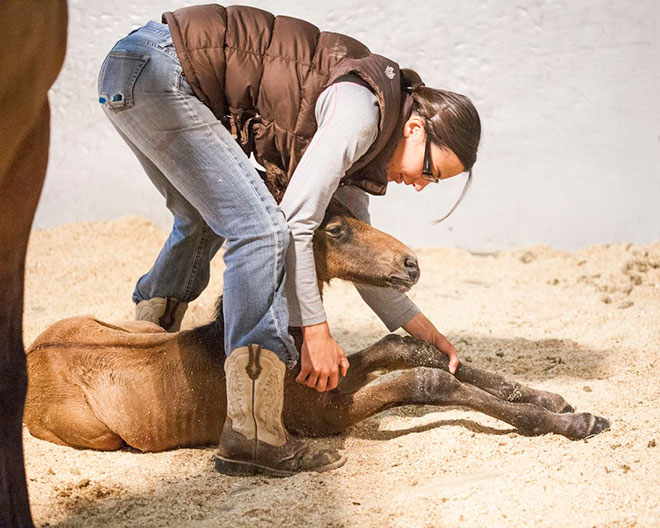
Dr. Jennifer Hatzel, Colorado State University
Aging Mares
As the market becomes more selective, veterinarians are tasked with generating pregnancies from older, more proven mares, calling on assisted reproduction to garner success. "The biggest thing is age," says Dr. Scoggin. "I think that most people would agree that's our greatest limiting factor. Especially in our Thoroughbred mares. We ask them to carry pregnancies their whole lives. There's no way around that part. These mares aren't spring chickens anymore, and anything we can do to up our chances of having them conceive, become pregnant then produce a live and healthy foal, that's really important." Inevitably a large percentage of the hard to breed cases that doctors Carnevale, Hatzel and Scoggin take on are due to the age of the mare. "We're unanimous in this," says Dr. Carnevale, "ultimately, the number one factor is age."
With older mares comes issues that challenge veterinarians in every way. "Inflammation is a big thing, especially in older mares," says Dr. Carnevale. "We're now getting to the point where we know that inflammation is more important than we previously considered." Inflammation in mares can have significant effects from fertility to the mare's ability to carry the foal to term. "As a result of age, we're seeing secondary inflammation in their distal limbs, joints, soft tissues and the supporting abdominal musculature that comes from carrying that many pregnancies year in and year out," says Dr. Scoggin. "Anything we can do to reduce inflammation and to keep them happy and healthy greatly increases our odds of obtaining a live foal."
Beyond the age-related issues associated with the uterus, reproductive tract and health of the oocyte, older mares often encounter roadblocks to their fertility in the way of metabolic concerns. "With metabolic mares there are a lot of changes occurring in the ovary that potentially affect oocytes and fertility," says Dr. Carnevale. It is in the struggle with metabolic mares that Dr. Carnevale sees most vividly the shift in her definition of success. "You don't just want an embryo, you want a foal. You don't just want a foal, you want a healthy foal. You don't just want a healthy foal, you want one that can perform," she says. "There are so many things that can naturally affect each of those steps. We're just learning about a lot of those factors. They're important not only for fertility, but for that offspring, the future of that offspring and potentially generations down the road."
Now more than ever, veterinarians are beginning to understand the lofty effects that the mare's health has on the foal in utero and beyond. "When mares are overweight, it changes the lipids in their oocytes," says Dr. Carnevale. "It changes follicular parameters, and we see inflammatory changes in the uterus." The implications are massive. Knowing that the metabolic health, weight, inflammatory levels and overall well-being of the mare could potentially impact not only the health of her foal but generations thereafter is incredibly important. "In overweight mares, we were seeing changes that suggest impacts on both the reproductive tract and potentially in the early embryo," says Dr. Carnevale. In fact, the importance of the mare's health starts well before the intention to breed her, with her metabolic health and weight impacting the oocyte and follicle. Dr. Carnevale is adamant about this, "the equine industry has to realize that if they're breeding a mare or they have an oocyte that's getting injected with sperm, anything that we do along the way can potentially affect the outcome. What's going on with that mare is affecting the oocyte, affecting the embryo, affecting the uterus and thus affecting the offspring."
An advocate of the mare, Dr. Scoggin shares Dr. Carnevale's insistence that successful breeding begins with the mare. More than evaluating a mare's reproductive tract to gauge her ability to conceive and carry a healthy foal, Dr. Scoggin insists there's a lot more to the equation. "We sort of do ourselves an injustice," he says. "We say we specialize in reproduction, but it's our goal to be a veterinarian first, and we have to look at the whole horse." For him this includes taking a step back, and essentially examining each mare head to hooves. "If we see that a mare has a problem getting pregnant, it takes us pausing and asking ‘could there be a reason for this? How do her feet look? Does she have any arthritic conditions that she's dealing with? Any abdominal issues? Is her gut flora ideal?' " He maintains that when theriogenologists look past the reproductive system alone and treat the horse in its entirety, greater success is often the outcome. It's a point that Dr. Carnevale echoes. "Our motto is, ‘you're breeding the horse, not the reproductive tract,' " she says. "It's great to get them pregnant, but in the end getting a healthy foal out of a healthy mare is really what we want."
Intracytoplasmic Sperm Injection (ICSI)
A routine procedure in human infertility, in vitro fertilization (IVF) has challenged the equine reproduction world. IVF, where the sperm and egg are placed together in a petri dish and left to fertilize, has proven unsuccessful in horses. While theriogenologists have struggled to crack the code of IVF in horses, intracytoplasmic sperm injection (ICSI) has emerged as a successful assisted reproduction technique that has revolutionized the industry. "We have essentially skipped in vitro fertilization in horses," says Dr. Scoggin. "We started doing ICSI to try and bypass having to do standard IVF." Dr. Carnevale notes "Although we started producing foals by oocyte transfer in 1999, it was around 2003 when we produced the first clinical foals by ICSI at CSU." ICSI is the process of injecting an oocyte with a single sperm, then the embryo can be grown in the lab for about seven days before doing a standard embryo transfer. It's popularity and success rates have risen dramatically, with Texas A&M performing 450 ICSI sessions last year alone in the laboratory of Drs. Katrin Hinrichs and Young Ho Choi. "The fact that we can make test tube babies is pretty exciting," says Dr. Varner. "It allows you to continue to use the limited frozen sperm banks of a stallion that may have died or become infertile. We can take one straw of frozen semen and make 100-1,000 ICSI doses." Dr. Varner points out that although ICSI has offered significant opportunities for successful breeding, it comes with a high cost to the horse owner and doesn't supersede the need for research into IVF. "We need to identify a way to ensure that sperm are capable of fertilizing an egg in a petri dish. A stallion's sperm are not immediately capable of fertilizing when they are ejaculated, they undergo a very complicated process referred to as capacitation," he says. "That process occurs naturally when the sperm are in the protected confines of the mare's oviduct." As of yet, researchers have been unable to duplicate the process of capacitation in the lab. "When sperm become capacitated," Dr. Varner continues, "they develop a hyperactive form of motility and they also have changes occurring in the membranes, so they're more likely to acrosome react when they come in contact with the egg itself." It is unclear whether the unsuccessful attempts at IVF in horses are due to a sperm-related issue, problem with the egg in a petri dish environment or a combination of both. Regardless, further research is needed to finally achieve successful IVF in horses and provide a more cost effective alternative to ICSI.
Translational Medicine
The similarities between human infertility treatments and the techniques relied upon in equine reproduction go far beyond IVF and ICSI. "The age-related work being done is so important," says Dr. Carnevale. "The older mare's problems are very similar to what happens in women when they're getting to be 35 and older." In addition to age, metabolic concerns such as metabolic syndrome and excess weight are frequent concerns in human mothers just as they are with mares. "Our research mirrors human reproductive medicine in many ways. The hot topics in the world of human reproduction are the hot topics in our world as well. Especially with metabolic concerns, obesity and age in both species," says Dr. Carnevale. Ask equine and human fertility specialists alike and you'll find that ultimately it's the offspring that hold their attention and concern. "The horse is providing a potentially good model for what's happening in humans, and vice versa," Dr. Carnevale says. Looking at the health of the mare and human mother, then following their offspring through their development is key in determining how to better treat the mother for the benefit of the foal or child.
One potential area being studied extensively in both human and veterinary medicine is the effect the mother's gut health has on the health and longterm well-being of the offspring. "I'm fortunate enough to sit on some abstract review committees," says Dr. Scoggin. "We see a lot of grants discussing the gut microbiome and how it may differ in a hospital situation versus a ranch or a farm." Similar research is being conducted in human medicine, with researchers studying the differences in a child's microbiome depending on whether they were born by way of natural delivery or by cesarean section. "There are certain things that we don't quite know about the microbiome, but we're headed there," says Dr. Scoggin. "The microbiome is a big topic of interest being explored — how do things differ from one setting to another, and how does that affect our success rates in maintaining a healthy horse or getting a successful pregnancy?"
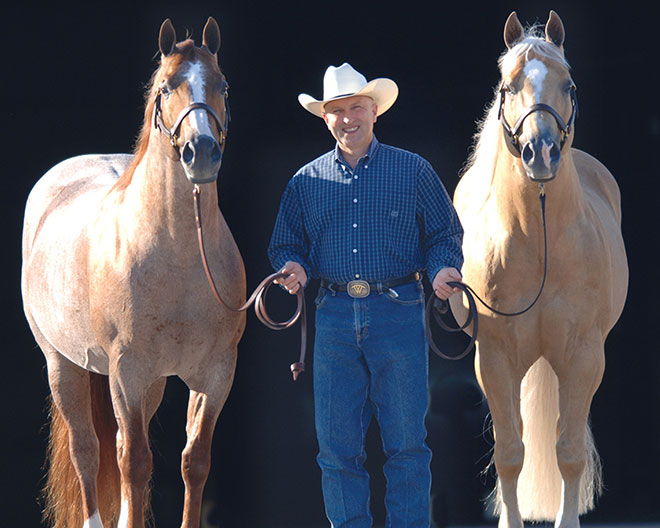
Dr. Dickson Varner, pictured with two elite stallions Peptoboonsmal (left), $25 + million dollar sire and Shining Spark (right), Leading AQHA sire of reining and cow horses.
PHOTO BY CAPPY JACKSON
The Stallion Man
Dr. Dickson Varner of Texas A&M University is to stallions what a Texas quarterback is to his team; head in the game, with a strategist's mind and an unwavering focus on the end goal. He's worked with the finest sires there are, yet you'd never know his caliber just by meeting him. Humble and gracious, Dr. Varner couples his intense passion for science with a deep affection for the horse. "I grew up the son of a cowgirl and cowboy, and they were rodeo producers," he says, a smile in his voice when recalling his childhood that reads like a whimsical western story. "I was exposed to a lot of animals when I was young. I always had a special love for animals, in particular for horses." His youth was spent working alongside his parents and siblings in the family's wild west show. He grew up surrounded by animals, and with him grew a love for horses that would eventually become more than his calling, but a passion that is just as alive today as it has been for every one of his 38 years in veterinary medicine. "When I graduated from veterinary school, I went to a broodmare farm in central Kentucky," he remembers. "It was a Standardbred breeding operation, and they had about 1,500 horses on the farm at the height of breeding season, so I got a lot of exposure as an intern." Following his internship, it was a residency in reproduction that sparked an interest in the stallion specifically and sent him down a path that has resulted in crucial breakthroughs in stallion fertility.
Dr. Varner has been there to witness the changes that have guided the breeding industry from where it was in the 1970s and 80s, to where it is today. "When I entered the veterinary profession, a full book of mares in the Thoroughbred industry was 40 to 45 being bred by a stallion in a five-month breeding season," he remembers. "There have been some major changes in the Thoroughbred industry today, where stallions breed 100 to upwards of 200 mares routinely, and shuttle stallions are exposed to two breeding seasons per year." He's referring, of course, to valuable stallions that breed during the season in the northern hemisphere before being transferred to the southern hemisphere, making for a near constant year-round breeding season. "We've made a lot of headway in the management of these stallions," says Dr. Varner. Technology has played an increasing role in the ability of theriogenologists to better manage not only fertility but also the overall health and longevity of stallions. "We have a software program developed by my colleague Dr. Charles Love, that we use to monitor the fertility of these stallions. We're able to use that program to differentiate intrinsic fertility issues in the stallion from mare-related factors that may be reducing a stallion's seasonal fertility statistics." With evolving technology, Dr. Varner and his colleagues are able to gather data that results in important lessons and fertility trends. "With some stallions, pregnancy rate is reduced when they breed three mares per day compared to one or two," he says. "With others, pregnancy rates are higher when they breed four mares per day versus one or two. And if they have one or two days of their fertility rate drops precipitously." Such data is helping veterinarians to better understand these fluctuations and work toward identifying trends. While stallion fertility is unquestionably his specialty, he considers himself a veterinarian first. "The general health of the stallion is my first concern," says Dr. Varner. "If they have hock issues, back issues or neck issues, for instance, those types of injuries can interfere with their interest in breeding. Their health comes first."
Stallions keep things interesting, not only due to their imposing stature and wildly varied temperaments, but because they are used for breeding purposes based on performance records rather than fertility. "Stallions are like men, we don't become sires based on our fertility," says Dr. Varner. "Dairy bulls, beef bulls, boars, rams and bucks must have good fertility to become sires. With the stallion, it's based on athleticism, performance record, pedigree and conformation with little regard for reproduction." With a surprising number of breeding stallions being subfertile at the outset, there is constant work being done to determine whether a genetic predisposition plays a significant role, if the cause is more commonly environmental in nature or, just as likely, a combination of the two. "As we learn more about the genome of the stallion, we'll be able to sort out genetic-related causes of subfertility in a more meaningful way," says Dr. Varner. "With that information, maybe the breed registries will have more interest in selecting stallions as sires based on good genetic composition for fertility, rather than purely on performance and pedigree."
Racing in particular is a prime example of this, as producing stallions that retire from the track with little to no exposure to mares require a recalibration of sorts. "They have the mindset of a bachelor stallion," says Dr. Varner. "One of our biggest challenges is to help stallions transition from a performance career to that of a breeding sire. Sometimes, we have to change a lot of management to achieve that goal." In addition to their lack of exposure to mares, racing Thoroughbred stallions can have decreased libido as a breeding season progresses, often caused by breeding multiple mares per day by live cover, as compared to the artificial insemination world of Quarter Horses where semen is collected 3-4 times per week.
Aging Stallions
All stallions share a common factor that will unavoidably impact their fertility at some point — age. Age is the constant foe of theriogenologists, not only playing a monumental role in a mare's declining fertility but also having a detrimental effect on the stallion. "All males, if they live to an old age, develop testicular degeneration regardless of the species," says Dr. Varner. "In older stallions, declining fertility is one of the concerns you have to deal with, and it's usually associated with a reduction in testicular size, a reduction in spermatogenic efficiency and semen quality. We see a progressive decline in these parameters that eventually leads to reduced fertility. With time those stallions become highly subfertile to sterile," he states. While this decline can happen to stallions in their teens or hold of until well into their twenties, it's an inevitable challenge that will be faced eventually with even the top performers. "Right now, we don't have any medical means to curb age-related demise of fertility," says Dr. Varner. Age and its effect on stallion fertility is a primary challenge, leaving ample room for new tools, discoveries and techniques to elongate the breeding career of valuable stallions.
“We’ve developed ways to improve the quality of the semen prior to insemination ... such that mares are inseminated with sperm of the best quality.”
— Dr. Dickson Varner, Texas A&M University
Advancements in Stallion Fertility
From Dr. Varner's early days as a theriogenologist, he's seen tremendous progress made in reproductive technology and techniques, progress responsible for improving outcomes of subfertile stallions. One such improvement is seen in semen processing, with advancements in this area allowing for greater success in artificially inseminated horses. "We've developed ways to improve the quality of the semen prior to insemination," says Dr. Varner. This has included methods to increase sperm concentration, diminish detrimental effects of seminal plasma on sperm, and separation of higher quality sperm from lower quality sperm, such that mares are inseminated with sperm of the best quality." In addition to sperm quality, dose is another factor that can determine how many breedings can be achieved from the available supply of semen. "We've designed low-dose insemination techniques whereby we can successfully breed mares with an insemination dose that's 500 to 1,000 times less than what we commonly used 30 years ago," says Dr. Varner. This allows for a semen supply to go further, improving profitability for breeders and resulting in a greater number of pregnancies from a single stallion.
Although numerous important advancements have been made in stallion fertility over the last four decades, Dr. Varner is hungry for more. To him, there remains far too much that we still don't know and a vast number of theories exist that could change the future of the breeding industry. The ability to more reliably predict a stallion's fertility, for instance, would help breeders separate high level performers from those stallions that will present challenges. "We don't have a singular laboratory assay or a battery of assays that provide us absolute predictability of a stallion's fertility," says Dr. Varner. "Emphasis in the future will be to try to identify that group of tests that allows us to speak with confidence when we predict a stallion's potential as a breeding sire." Dr. Varner is confident that the future will see theriogenologists incorporating more in-depth laboratory techniques, including many molecular based tests, to examine semen quality, including blood tests to analyze genetic susceptibility to reduced fertility.

PHOTO BY DAVID R. STOECKLEIN
The Role of Nutrition
The importance of nutrition in successful breeding programs has become more generally understood and well accepted over the last 20 years. The use of quality nutrition programs has become commonplace in both university and clinical settings, as well as on the breeding farm. "People are now more cognizant of the role of nutrition for maintaining the health of an animal," says Dr. Varner.
Omega-3 fatty acids, perhaps more than any other nutrient, have been studied in various aspects of equine reproduction with promising results. In terms of the stallion, the beneficial effects of omega-3's and antioxidants have been seen specifically in the sperm membrane. "By bumping up the omega-3 fatty acid content, specifically DHA, in their diet, that could have some membrane stabilizing effects, maintaining more intact membranes and improving mitochondrial function and motility," says Dr. Scoggin. "It has even been suggested that this may improve testicular function, sperm output and semen quality," adds Dr. Varner. "Those supplemented omega-3 fatty acids incorporate into all membranes — sperm membranes, liver cell membranes, the heart … virtually every cell type in the body." It has been shown that sperm are exposed to a significant amount of free radicals, and when higher levels of unsaturated fatty acids are incorporated into sperm membranes, these cells can become particularly susceptible to oxidative injury due to the presence of free radicals. "We have strived to have a method to reduce the effect of free radical production on membrane- and DNA-related oxidative injury, while providing the positive effects of supplemental omega-3 fatty acids on testicular function," says Dr. Varner. "To that extent, we now incorporate vitamin E, vitamin C and alpha lipoic acid with the omega-3 fatty acid supplement." By combining potent antioxidants with omega-3 fatty acids, the combination is believed to be beneficial to sperm health.
From a mare perspective, Dr. Carnevale uses nutrients as a tool for several aspects of the mare's health and reproduction. "Inflammatory changes are having deleterious effects," she says. Dr. Scoggin agrees, "Nutrition allows us to help the entire horse, and it's one of our most important methods. There is more and more great research coming out regarding the benefits of nutrition, particularly omega-3 fatty acids and antioxidants. They affect so much on the outside of the horse that you just have to think there are positive effects on the inside, in the uterus and on the mare as an incubator," he says. "We believe in these nutrients and use them for so many mares, and I hate to use the term ‘supplement' because it's really part of our routine program, no different than the feed we give them. It's all necessary." The goal is to use nutrition to influence the health of every facet of the reproductive system by first starting with a healthy and thriving mare. "A lot of our success has gone along with the overall improvement of nutrition and the well-being of horses," says Dr. Hatzel. It starts long before the mare is bred by providing the right nutrition with adequate levels of omega-3 fatty acids and antioxidants. With this, researchers are hoping to impact the quality of the follicle and oocyte as well as the health and function of the uterus. "I've relied on nutrition as an important tool for quite a while," says Dr. Scoggin. "We're seeing benefits — whether that be sperm motility, mares breeding back easier, or getting bred and not having a lot of fluid post breeding. I think that field data veterinarians are seeing is going to increase the use of nutrition moving forward."
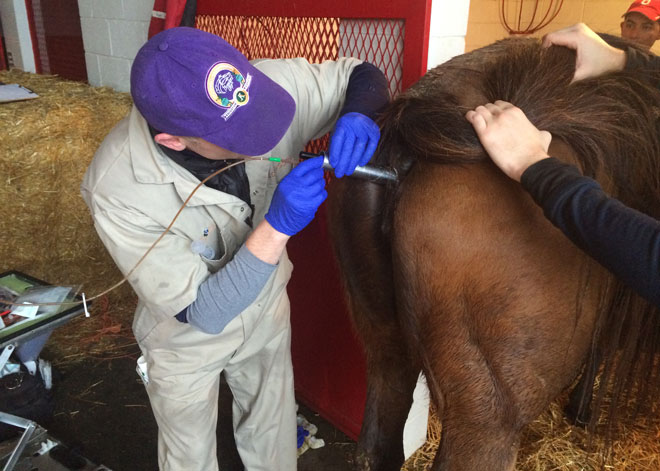
Dr. Charlie Scoggin, Rood & Riddle Equine Hospital
For the Love of the Horse
More than the research, breakthroughs and accolades, each of the four theriogenologists gravitated to their field for a simple love of the horse. That admiration for the animal has spurred tremendous progress and moved the breeding industry forward in ways that perhaps won't be fully realized for decades to come. Ask any of them, and you'll hear a remarkable enthusiasm for their field. "I love working with the horses," says Dr. Carnevale. "Some of them are just beyond phenomenal and they're life changing. With them usually comes phenomenal people that have really made a difference in all of our lives." She's constantly in awe of the people and horses that she serves, and it's evident in her voice just as it is with Dr. Hatzel. "I really enjoy the successful pregnancies that we're able to get for people that may have had a mare die unexpectedly," says Hatzel. "They ship ovaries, and we have the ability to get one last pregnancy or one final foal out of that blood line, and that's really an amazing opportunity. To be able to do that for a client is so gratifying."
Like his mentor Dr. Carnevale, Dr. Scoggin is driven by the desire to be one of the greats in his field. It's not for the ego but rather he's after the long list of things he'd like to achieve for the benefit of the horse. "I look at myself as a veterinarian first, and then a specialist in reproduction," he maintains. "It greatly interests me. I enjoy being a part of it, and I hope it allows me to leave a legacy some how, in some way." It's a legacy that is already well on it's way, as it is for fellow theriogenologist Dr. Varner. To Varner, his life, career and accomplishments are due in large part to his tight-knit inner circle. "I have been here at Texas A&M for the past 30 years, so you can see that I don't move around too much," he says with a laugh. "My dreams became a reality when folks like Drs. Katrin Hinrichs, Terry Blanchard, Charley Love and Steve Brinsko also moved to Texas A&M University. We aren't just colleagues, we're family, and I couldn't envision a more perfect scenario for a professional career."
To these four great minds, having a hand in creating life is not only what drives them, it's what defines their life's work. Past the big ideas, intense focus and relentless determination, it comes down to new life, new discovery and the opportunity that brings. Perhaps Dr. Varner has the equation for success figured out, "surround yourself with brilliant minds that thoroughly enjoy the discipline and build a family-like relationship together," he says. "It all follows from there."

by Jessie Bengoa,
Platinum Performance®
